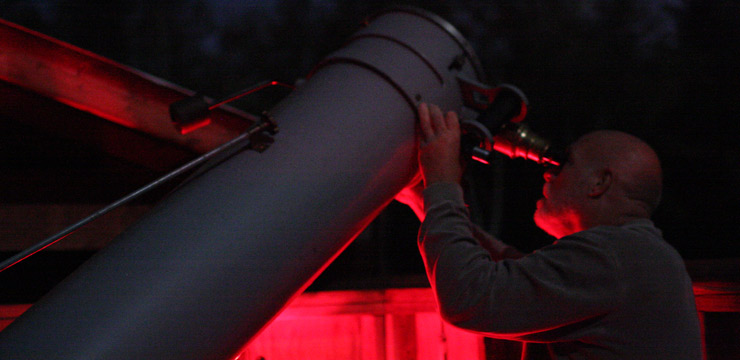
Observations of the November 2022 Lunar Eclipse
December 2022 :
Note: This article may contain outdated information
This article was published in the December 2022 issue of The Skyscraper and likely contains some information that was pertinent only for that month. It is being provided here for historical reference only.
I can't even say how many lunar eclipses I have seen over the years. I wish I had kept count, but it really doesn't matter. There is just something special about each eclipse, and no two have been the same.
The different experiences come from a number of factors. First of all, the appearance of the Moon is determined by the amount of particulates and aerosols in Earth's atmosphere, affecting the color and brightness of the Moon at mid-eclipse. The appearance can range from a bright copper-colored Moon if our atmosphere is predominantly clear, to a dull, brick red, if more of the sunlight is being scattered due to recent forest fires and/or volcanic eruptions here on earth. I can recall one lunar eclipse that we observed from Ladd Observatory many years ago when the Moon simply disappeared from view, leaving nothing more than a dark spot in the sky.
Another influence that will add to the experience, and an important one to me, is the location one chooses to observe an eclipse from. I have observed previous eclipses from a variety of locations. A more recent one was from home, just after an ice storm that left tree branches coated with ice, and a gentle breeze that night that made swaying branches sound like the clinking of crystal glass. Another time I observed and photographed an eclipse from Beavertail State Park, listening to the waves crash against the rocks, and the sound of the lighthouse horn periodically piercing the quiet of the night.
And finally, one has the choice of making their observations something to enjoy as either a solitary experience, or to join in with others. When you read the personal accounts from others, you will see that their experiences differ from one another, each one unique to the individual observer.
Because this eclipse happened so early in the morning, I opted to keep my photographic ambitions in check by not lugging a lot of equipment into the field at such an early hour. Instead, my plan was to simply enjoy watching the eclipse with a portable, small telescope and a pair of binoculars. I wanted to observe this eclipse from a location that was not far from home, and had a scenic view looking towards the western horizon, allowing me the opportunity to enjoy the eclipse, low in the west during the pre-dawn sky.
In scouting locations ahead of time, a couple of friends invited me to check out the view from their home, perched on a hill in nearby Connecticut. This turned out to be the perfect location for the photograph I had envisioned - distant, rolling hills,with a village nestled in the valley below, complete with a church that has a tall steeple.
I enjoyed observing this lunar eclipse, from first contact all the way until the sky got so bright that it was difficult to still see the Moon. Most of my observations were done from relaxing in a folding chair and observing with a pair of binoculars. I would occasionally get up and view through my small telescope, but honestly, I think I enjoyed the more three dimensional view that the binoculars provided, showing the bright, copper-colored Moon at mid-eclipse, floating among the stars. My camera setup was simple - just my 35mm DSLR with a 50mm lens on a sturdy tripod. At mid-eclipse, I took a few photos, and the one presented here is the one that I think best captures the experience I had - a beautiful, eclipsed Moon hanging in a star-filled sky over a scenic landscape.

Related Topics




